It's an interesting story as to how Joel and Sally procured most of these wines. Earlier this year, they visited
France and South Africa, along with Dave and Mary. While in the
Rhône Valley, they collected two cases of primo Côte Rotie to take to South Africa, where folks see little, if any of these wonderful expressions of syrah. A tasting was then held in
Stellenbosch, hosted by Goldberg buddies and Cape Wine Masters
Margie Barker and Greg De Bruyn and attended by some of the leading figures in the local wine industry; those present were asked to contribute bottles of South African wine that rarely, if ever make it to the US, in order to fill the empty cases that had held the Côte Roties. Those bottles then came home with the Goldbergs, and the rest is (t)history. (Note: stars given in the notes are ratings given by the
Platter Wine
Guide, the consensus authority on South African wines.)
We got started out on the back deck with assorted cheeses, bread and crackers and an off-topic wine, since the Rome's had yet to arrive, and they were bringing the lone white of the lineup.
2002 Peninsula Cellars Old Mission Peninsula Gewurztraminer Manigold Vineyard, 14.3% alc.: Peninsula Cellars is one of the rising stars among Michigan wineries, having won national awards for their 2002 Rieslings in the past several months. This pale straw is another fine effort, with lots of peach and pear character, with some litchi nuances in support. Viscous and somewhat oily, it has very nice concentration and intensity, and gives yet another reason to drop "…for Michigan" as a qualification to the statement, "This is a very nice wine."
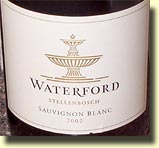 2002 Waterford Sauvignon Blanc Stellenbosch, 13% alc. (3.5*): According to Lewis and Joy, this has really fallen off in quality since they tasted it a year ago. It's a pale to medium straw in color, with soft grapefruit-pear on the rather subdued nose. It picks up some mineral and intensity on the palate, but it doesn't show a lot of sauvignon character. Lewis commented that it "was full of flowers and fruit a year ago," while Joy simply called it "disappointing." Dave opined, "It seems like it's getting a little old," while Sally diplomatically described it as "a little austere." It does open some with air, and it's by no means a bad wine, but… 2002 Waterford Sauvignon Blanc Stellenbosch, 13% alc. (3.5*): According to Lewis and Joy, this has really fallen off in quality since they tasted it a year ago. It's a pale to medium straw in color, with soft grapefruit-pear on the rather subdued nose. It picks up some mineral and intensity on the palate, but it doesn't show a lot of sauvignon character. Lewis commented that it "was full of flowers and fruit a year ago," while Joy simply called it "disappointing." Dave opined, "It seems like it's getting a little old," while Sally diplomatically described it as "a little austere." It does open some with air, and it's by no means a bad wine, but…
Joel called the following two selections "the yin and yang of pinotage," and it didn't take long to see what he meant. They were enjoyed with delicious grilled South African beef sausages (boerwors) that had to be ordered over the Internet.
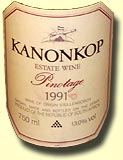 1991 Kanonkop Pinotage Stellenbosch, 13% alc. (4.5*): Only one pinotage has ever impressed this taster (most of what is available in Southeastern Michigan is swill), and it came from this producer, so it wasn't surprising to find
this a very enjoyable wine. There's still not much rust to the dark garnet color, and it's showing beautiful flavors and aromas of red currant and black cherry, with overtones of saddle leather. Indeed, Bree commented, "It smells like a tack room," adding an impression of "a certain rusticity to the aromatics; it has a great deal of character." Joel called it "the benchmark, what pinotage should taste like." 1991 Kanonkop Pinotage Stellenbosch, 13% alc. (4.5*): Only one pinotage has ever impressed this taster (most of what is available in Southeastern Michigan is swill), and it came from this producer, so it wasn't surprising to find
this a very enjoyable wine. There's still not much rust to the dark garnet color, and it's showing beautiful flavors and aromas of red currant and black cherry, with overtones of saddle leather. Indeed, Bree commented, "It smells like a tack room," adding an impression of "a certain rusticity to the aromatics; it has a great deal of character." Joel called it "the benchmark, what pinotage should taste like."
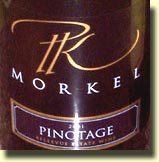 2001 Bellevue Estate Pinotage Stellenbosch "P.J. Morkel", 13% alc. (4.5*): Joel characterized this deep dark garnet as "a big modern pinotage, with none of the old esters in it," and it's all about big oak and big fruit, with its sweet, toasty black cherry, black raspberry and blueberry flavors and aromas that show hints of chocolate and maple syrup with air. Joel speculated that this "will develop nicely in the bottle, with some of the qualities of the Kanonkop, despite the international style," but Mr. Bree took a different stance, calling it "all oak and mirrors." It was his opinion that the sweet fruit was due more to some residual sugar than ripe fruit, and while I'm not sure that I agree, it should be interesting to see how it fares over time. Personally, I liked this quite a bit, though I preferred the Kanonkop. 2001 Bellevue Estate Pinotage Stellenbosch "P.J. Morkel", 13% alc. (4.5*): Joel characterized this deep dark garnet as "a big modern pinotage, with none of the old esters in it," and it's all about big oak and big fruit, with its sweet, toasty black cherry, black raspberry and blueberry flavors and aromas that show hints of chocolate and maple syrup with air. Joel speculated that this "will develop nicely in the bottle, with some of the qualities of the Kanonkop, despite the international style," but Mr. Bree took a different stance, calling it "all oak and mirrors." It was his opinion that the sweet fruit was due more to some residual sugar than ripe fruit, and while I'm not sure that I agree, it should be interesting to see how it fares over time. Personally, I liked this quite a bit, though I preferred the Kanonkop.
From there, we moved in to the dining room, and on to the Pinot Noir and Zinfandel. The dinner main course was Malay Curried Lamb, accompanied by yellow rice and curried green beans -- all Cape recipes.
2001 Paul Cluver Pinot Noir Elgin, 14.5% alc. (4*): There's not much nose to this ruby dark garnet, but some earthy plum and black cherry comes out more in the flavors, where it shows good body, concentration and intensity. More New World in style than the following selection, it also shows less varietal typicity, but should improve nicely over the next three to five years.
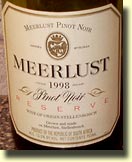 1998 Meerlust Pinot Noir Reserve Stellenbosch, 13.5% alc. (4*): The Gang contribution to the tasting, and like the Cluver, there's not a lot on the nose of this ruby dark garnet, but the flavors pick it up nicely with some tarry plum and black cherry with hints of coffee, and "some funky earthiness that I kind of like," according to Joel. It's silky smooth on the palate, but not showing a lot of varietal typicity, and Lewis found the finish to be a bit hot. Not quite as impressive as the one we took to MoCool last year. 1998 Meerlust Pinot Noir Reserve Stellenbosch, 13.5% alc. (4*): The Gang contribution to the tasting, and like the Cluver, there's not a lot on the nose of this ruby dark garnet, but the flavors pick it up nicely with some tarry plum and black cherry with hints of coffee, and "some funky earthiness that I kind of like," according to Joel. It's silky smooth on the palate, but not showing a lot of varietal typicity, and Lewis found the finish to be a bit hot. Not quite as impressive as the one we took to MoCool last year.
Both Pinots are pleasant and enjoyable, though neither are exceptional wines. Next was the Paarl version of California's "native wine grape," served up with intent to tickle
califusa's palate.
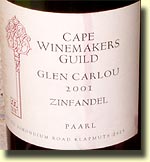 2001
Glen Carlou Zinfandel Paarl CWG Auction Reserve, 15.5% alc. (3.5*): This is an inky dark garnet in color, with a big sweet toasty oak, black berry, black raspberry and blueberry personality, being very Left Coast-like; Joel found it reminiscent of a
DeLoach OFS Zin. It's a drink-me-tonight kind of wine, with sweet, rich fruit and an almost creamy texture. Bree didn't much like this, but I found it to be enjoyable. 2001
Glen Carlou Zinfandel Paarl CWG Auction Reserve, 15.5% alc. (3.5*): This is an inky dark garnet in color, with a big sweet toasty oak, black berry, black raspberry and blueberry personality, being very Left Coast-like; Joel found it reminiscent of a
DeLoach OFS Zin. It's a drink-me-tonight kind of wine, with sweet, rich fruit and an almost creamy texture. Bree didn't much like this, but I found it to be enjoyable.
Then it was on to the Bordeaux varietals, starting with a "disappointing" 13-year-old selection.
1990 Buitenverwachting "Christine" Bordeaux Blend Constantia, 13% alc. (4.5*): This shows a slightly cloudy dark garnet color, and features more leather and earth than fruit on the nose. There's some decent black currant and plum on the palate, but Sally described it as "dried up," and Joel called it "tired," adding, "There's some serious cedar and cigar box, but less development than I'd hoped for. Perhaps this was just an off bottle, and not representative of the wine, but not having another, Joel zipped down to the cellar for an old favorite of Lewis'.
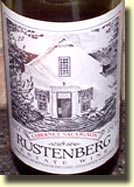 1990
Rustenberg Cabernet Sauvignon Stellenbosch, 12% alc. (4*): A slightly rusty dark garnet, this features tar and earth on the nose, along with soft, yet intense dusty red currant flavors, along with what Dave described as "a hint of the barnyard," and a long finish. All in all, this is much more enjoyable than the '90 "Christine", being a very nice, mature claret that has yet to peak. 1990
Rustenberg Cabernet Sauvignon Stellenbosch, 12% alc. (4*): A slightly rusty dark garnet, this features tar and earth on the nose, along with soft, yet intense dusty red currant flavors, along with what Dave described as "a hint of the barnyard," and a long finish. All in all, this is much more enjoyable than the '90 "Christine", being a very nice, mature claret that has yet to peak.
1999 Buitenverwachting "Christine" Bordeaux Blend Constantia, 14% alc. (4.5*): Joel called this deep dark garnet "the antithesis of a Parker wine; it's elegant and in balance, without gobs of fruit." Herbs and blackfruit waft out of the glass, and on the palate, there is lovely black currant, cassis and plum to be found, along with some nice coffee notes. Flavors take on more herbal characteristics as it opens, and Dave got a note of bell pepper, as well. Sleek and beautiful, this beauty needs at least five years to show at its best.
Next came two varieties of the South African syrah experience, and again, Joel described them as "the yin and yang" of that realm, adding that both come from old properties.
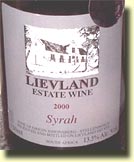 2000 Lievland Estate Syrah Stellenbosch, 13.5% alc. (4.5*): Joel said that this dark garnet might be Lievland's best ever syrah, and it certainly is impressive, with its smoky bacon fat, plum character that shows hints of the barnyard. It's gamy, not too tannic and reminiscent of a good northern Rhône; as it opens it gets even gamier. It was everyone's favorite of the two, although Bree described it as "very disjointed (?!)." 2000 Lievland Estate Syrah Stellenbosch, 13.5% alc. (4.5*): Joel said that this dark garnet might be Lievland's best ever syrah, and it certainly is impressive, with its smoky bacon fat, plum character that shows hints of the barnyard. It's gamy, not too tannic and reminiscent of a good northern Rhône; as it opens it gets even gamier. It was everyone's favorite of the two, although Bree described it as "very disjointed (?!)."
2001 Fairview Shiraz Paarl "Solitude", 15% alc. (4*): From the producer of the popular
"Goats do Roam" and
"Goat Rotie" bottlings that have in short order become the top-selling South African imports to the US and Canada, this inky purple garnet is much darker than the Lievland, to the point of being opaque. It could easily be mistaken for an Aussie, with its big fruit, sweet oak, dill, plum and blueberry flavors and aromas; Kim mentioned a lot of peppermint on the nose. I liked this more than some of the other attendees; yes, it's a fruit bomb, but at least it doesn't exude ethanol-like fumes, as do some of the products of a certain Australian producer that seems to be all the rage in the US market these days.
2000 Steytler (Kaapzicht Estate) Cape Blend Stellenbosch "Vision", 14% alc. (4.5*): Joel characterized this opaque purple garnet as "the future of South African wines," as the Cape Blend designation indicates a Bordeaux blend with added pinotage, in this case, 20%, giving it a unique quality that can't be recreated anywhere else in the world. It's very open and accessible, with its deep dark black currant and blackberry flavors and aromas that are shaded with spice and pepper. The pinotage is very apparent in this lovely wine, and Joel and Dave disagreed slightly as to how far the silky tannins will take it; Joel said fifteen years, while Dave estimated five to ten. Personally, I'd vote less than more years, but whatever the case, this was the red wine of the night, hands down.
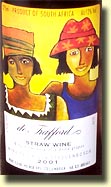 2001
De Trafford "Straw Wine" Stellenbosch, 12% alc. (5*): Called "straw wine" because the Chenin Blanc grapes are carefully laid out on a bed of straw and dried before being pressed, this is a tremendous alternative to Icewine in a region that can't DO Icewine. Medium gold in color, this is all about huge apricots, with a nice kiss of oak. It's certainly sweet, and very intense, but it's not cloying. Everything is in balance, nothing is over the top. Bree described it as having "urns of ubiquitous unctuousness," and said that it reminded him of a Tircoul Cuvee Madame, which I would definitely agree with. This bottle was a gift from the winemaker to the Goldbergs; Joel described it as "scarcer than hen's teeth," adding "you'll never see this in the US market." Just a marvelous dessert wine, and a very rare drinking experience. 2001
De Trafford "Straw Wine" Stellenbosch, 12% alc. (5*): Called "straw wine" because the Chenin Blanc grapes are carefully laid out on a bed of straw and dried before being pressed, this is a tremendous alternative to Icewine in a region that can't DO Icewine. Medium gold in color, this is all about huge apricots, with a nice kiss of oak. It's certainly sweet, and very intense, but it's not cloying. Everything is in balance, nothing is over the top. Bree described it as having "urns of ubiquitous unctuousness," and said that it reminded him of a Tircoul Cuvee Madame, which I would definitely agree with. This bottle was a gift from the winemaker to the Goldbergs; Joel described it as "scarcer than hen's teeth," adding "you'll never see this in the US market." Just a marvelous dessert wine, and a very rare drinking experience.
1993 Overgaauw Estate CIWG (Cape Independent Winemakers
Guild, which holds an annual auction of special-release wines from its members, since renamed the
CWG -- Cape Winemakers Guild) Vintage Reserve Touriga Nacional Stellenbosch, 17.3% alc. (Wine Magazine 5*): Dave described this inky garnet ersatz Port as smelling "like paint," and Joel amended that to "water based paint." It shows alcohol, Port, chocolate and black cherry flavors and aromas, being very nice, taken on its own terms, but something of a step down, after the "Straw Wine." It's drier than we would have expected, having neither the depth nor the sweetness of Port, and would likely pair well with a good mild cigar. Bree summed it up for us all with his
wise-crack, "It's a good example of nothing I've ever tasted before."
We've come to expect nothing less than special occasions from the Goldberg's themed wine dinners, and yet, this may have even exceeded those expectations. Kim and I have had some experience with South African wines back in the early to mid-90s. At that time, you could find very good wines from the likes of Meerlust and
Simonsig here in the Detroit area, but for whatever reason, they've become much harder to find, and that's a shame, because they're obviously doing some very good things down there. Joel
explained that since Apartheid is gone, countries that once
boycotted SA products now welcome the wines, and wineries find
it far easier to export to the EU for example, than to
negotiate the regulations of the US market. He also
commented
that there is a struggle to find an identity to the wines of South Africa going on, and perhaps that showed in this tasting, especially with the variations of pinotage and syrah/shiraz. Will a more traditional style win out, or will it be the "international?" Maybe there's room for both! Personally, I found the "Cape Blend" to be quite exciting, and hope that we can somehow get our hands on more of the stuff to follow the progress along those lines.
As always, many thanks to the Goldbergs for their very generous hospitality, and their very creative concept of themed wine dinners. Thanks also to the attendees for… well, for attending! It was a gas!
BACK TO THE TOP
|